Marrying Vega and Zen: The AMD Ryzen 5 2400G Review
by Ian Cutress on February 12, 2018 9:00 AM ESTBenchmarking Performance: CPU System Tests
Our first set of tests is our general system tests. These set of tests are meant to emulate more about what people usually do on a system, like opening large files or processing small stacks of data. This is a bit different to our office testing, which uses more industry standard benchmarks, and a few of the benchmarks here are relatively new and different.
All of our benchmark results can also be found in our benchmark engine, Bench.
PDF Opening
First up is a self-penned test using a monstrous PDF we once received in advance of attending an event. While the PDF was only a single page, it had so many high-quality layers embedded it was taking north of 15 seconds to open and to gain control on the mid-range notebook I was using at the time. This put it as a great candidate for our 'let's open an obnoxious PDF' test. Here we use Adobe Reader DC, and disable all the update functionality within. The benchmark sets the screen to 1080p, opens the PDF to in fit-to-screen mode, and measures the time from sending the command to open the PDF until it is fully displayed and the user can take control of the software again. The test is repeated ten times, and the average time taken. Results are in milliseconds.
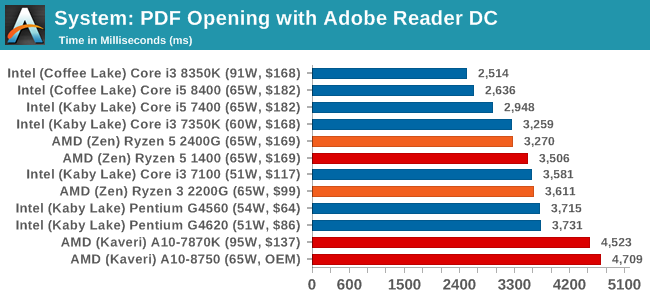
Our PDF test relies mostly on single core frequency, but memory frequency can also help. The 2400G pips the 1400, and the older AMD processors take a back seat. This is the sort of test that Intel's 4.2 GHz chips can take advantage off, as shown by the Core i3-8350K.
FCAT Processing: link
One of the more interesting workloads that has crossed our desks in recent quarters is FCAT - the tool we use to measure stuttering in gaming due to dropped or runt frames. The FCAT process requires enabling a color-based overlay onto a game, recording the gameplay, and then parsing the video file through the analysis software. The software is mostly single-threaded, however because the video is basically in a raw format, the file size is large and requires moving a lot of data around. For our test, we take a 90-second clip of the Rise of the Tomb Raider benchmark running on a GTX 980 Ti at 1440p, which comes in around 21 GB, and measure the time it takes to process through the visual analysis tool.
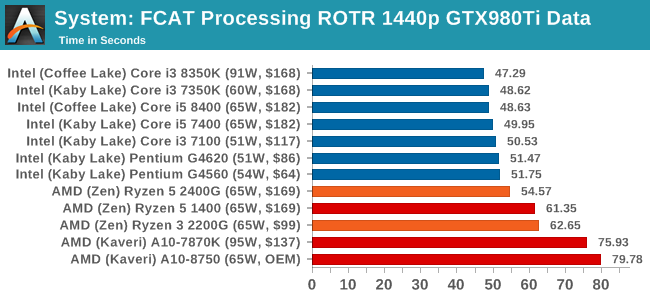
The FCAT program is single threaded, so again Intel's chips take a win here. The Ryzen 5 2400G takes another chunk out of the Ryzen 5 1400, due to its higher frequency.
Dolphin Benchmark: link
Many emulators are often bound by single thread CPU performance, and general reports tended to suggest that Haswell provided a significant boost to emulator performance. This benchmark runs a Wii program that ray traces a complex 3D scene inside the Dolphin Wii emulator. Performance on this benchmark is a good proxy of the speed of Dolphin CPU emulation, which is an intensive single core task using most aspects of a CPU. Results are given in seconds, where the Wii itself scores 1,052 seconds (17.53 minutes).
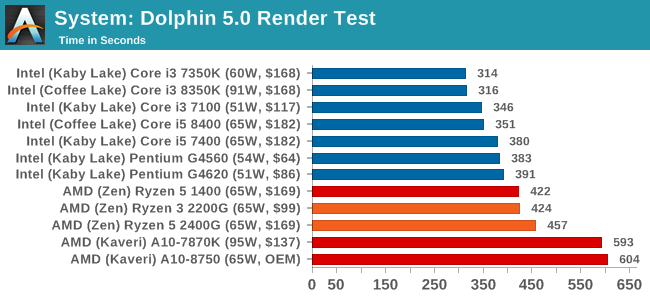
3D Movement Algorithm Test v2.1: link
This is the latest version of the self-penned 3DPM benchmark. The goal of 3DPM is to simulate semi-optimized scientific algorithms taken directly from my doctorate thesis. Version 2.1 improves over 2.0 by passing the main particle structs by reference rather than by value, and decreasing the amount of double->float->double recasts the compiler was adding in. It affords a ~25% speed-up over v2.0, which means new data.
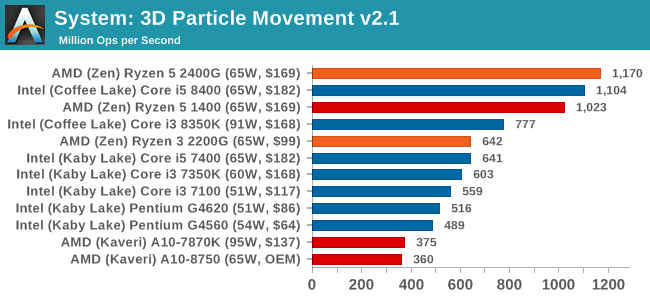
3DPM is our first multi-threaded test, and the Ryzen 5 2400G powers ahead over the 1400 due to frequency, and ahead the Core i3-8350K due to thread count. This is a benchmark that can take advantage of multithreading, so the quad-core APU with eight threads pushes ahead of the six-core Intel Core i5-8400.
DigiCortex v1.20: link
Despite being a couple of years old, the DigiCortex software is a pet project for the visualization of neuron and synapse activity in the brain. The software comes with a variety of benchmark modes, and we take the small benchmark which runs a 32k neuron/1.8B synapse simulation. The results on the output are given as a fraction of whether the system can simulate in real-time, so anything above a value of one is suitable for real-time work. The benchmark offers a 'no firing synapse' mode, which in essence detects DRAM and bus speed, however we take the firing mode which adds CPU work with every firing.
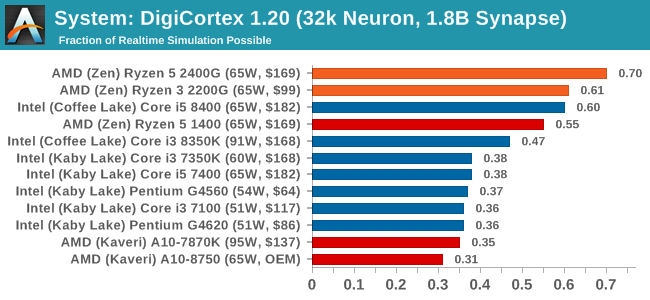
Agisoft Photoscan 1.3.3: link
Photoscan stays in our benchmark suite from the previous version, however now we are running on Windows 10 so features such as Speed Shift on the latest processors come into play. The concept of Photoscan is translating many 2D images into a 3D model - so the more detailed the images, and the more you have, the better the model. The algorithm has four stages, some single threaded and some multi-threaded, along with some cache/memory dependency in there as well. For some of the more variable threaded workload, features such as Speed Shift and XFR will be able to take advantage of CPU stalls or downtime, giving sizeable speedups on newer microarchitectures.
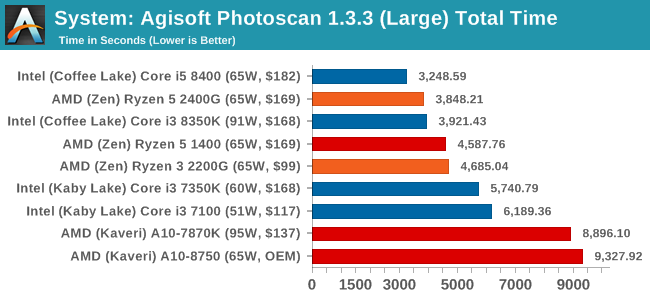
For Photoscan, certain elements of the algorithms require full cores to get the best performance, hence why the six-core CPU comes top and the Ryzen 5 2400G and Core i3-8350K are matched. That being said, the multithreading of the 2400G outweighs the extra frequency of the 8350K.










177 Comments
View All Comments
speely - Monday, February 12, 2018 - link
"Where is the i5-8400 that has the same price as the 2400G?Oh, yeah, they totally left it out from the benchmarks since it would have proved an absolute supremacy of the Intel offering.
Ops."
In which benchmarks do you expect to see the i5-8400 prove its "absolute supremacy" where the i5-7400 didn't? Seriously, I'd like to know.
Because what I see is either the i5-7400 beating the 2400G or going punch to punch with it, or being thoroughly decimated by it.
If the i5-7400 beats or competes with the 2400G, the i5-8400 refresh chip will do the same. If the i5-7400 gets trounced by the 2400G, the i5-8400 refresh chip isn't suddenly and magically going to beat it.
I fail to see anything in the article to indicate a pro-AMD bias on AT's part, either intentional or unintentional.
What I do see is a fanboy who's upset to see his team losing some benchmarks.
Kamgusta - Monday, February 12, 2018 - link
Ehm sir, 7400 is 4 core and 8400 is 6 core.Other reviews shows a 30% performance dominance of i5-8400 over the 2400G.
speely - Monday, February 12, 2018 - link
Fair point, and my apologies. I keep forgetting that they upped the i5's to 6 cores after a decade of 4c4t i5's (including the 4690K I currently use).That being said, the i5-8400 itself is the same price as the 2400G, but getting the i5-8400 running is not the same price as getting the 2400G running. The 2400G was tested on an MSI B350I Pro AC (https://www.anandtech.com/show/12227/msi-releases-... which is new and doesn't yet have a publicly-known MSRP, but is built and featured like other $70-80 B350 motherboards. What motherboards are on the market today for $70-80 that support the i5-8400?
So we've taken into account the additional 2 cores and the subsequent boost to the CPU-focused benchmarks, which the 7400 sometimes lost and sometimes won against the 2400G, and put a couple small notches into the 8400's belt. For another 50 bucks or so on the motherboard just to use the 8400, that's not too bad I suppose. It's what I would expect pitting a 6c6t CPU against a 4c8t CPU in CPU benchmarks. It's certainly not "absolute supremacy" but it's something, right?
Were you expecting that "absolute supremacy" to show up in iGPU gaming? I'll just laugh about that and move on.
Sure, the 8400 could probably step past the 2400G in gaming and graphics if you paired it with a $120-or-so graphics card (assuming you can find one at $120 or so), but then you're comparing a dGPU to an iGPU and you're still only barely stepping past.
So the only real way to make the 8400 show "absolute supremacy" over the 2400G is to cherry-pick just the benchmarks you like, and bolster the 8400 with another $200 of additional hardware.
"Absolute supremacy".
Manch - Monday, February 12, 2018 - link
No it's not.In regards to vs the 8400, its a mixed bag. For programs that favor Intel CPU's there is a clear advantage. For programs that favor AMD the advantage swings the other way. For everything else that's generally proc agnostic they tie, pull ahead slightly or gets beat relatively evenly in regards to CPU performance.Now GPU wise, it gets crushed. That's obvious that is gonna happen.
If you plan on getting a DGPU with some beef, either is good, If you looking to game on the cheap, which is the target of the AMD proc in this review, its the hands down winner. Comparable perf, but with a beefier iGPU that can hang with a 1030. Also it gives you the option of adding a DGPU later when you need more grunt. It's clearly the better buy this go around. No other site that Ive seen has argued against this.
dromoxen - Tuesday, February 13, 2018 - link
Are these going to get a 12nm refresh , as all the other ryzen cpus? I am thinking of upgrade either i58400 or r5 1600/1700 or possibly 2400g.. decision decisions ...Manch - Wednesday, February 14, 2018 - link
Originally it was labeled as 12nm, now referred to 14nm+.Probably will be updated.cheshirster - Monday, February 12, 2018 - link
You need Z370 for the "supremacy" to work.Ops.
bug77 - Monday, February 12, 2018 - link
That will be fixed when lower tier 300-series chipsets launch. However, it's a significant problem for those wanting to build a cheap setup until then.Ian Cutress - Monday, February 12, 2018 - link
I used the chips I have on hand for the tests, forgot to add already tested chips - we haven't tested the i5-8400 IGP, but the CPU results are on hand in Bench. I can add those results to the graphs when I get a chance.Manch - Monday, February 12, 2018 - link
Ian, I dont know if fhis is just when browing from a phone but the bench when listing CPUs while alphabetic, bc of the chips names ~lake, etc. The listing jumps all over the place. 8 series before 4 seriez then 7 series. Can yall fix this? Thanks